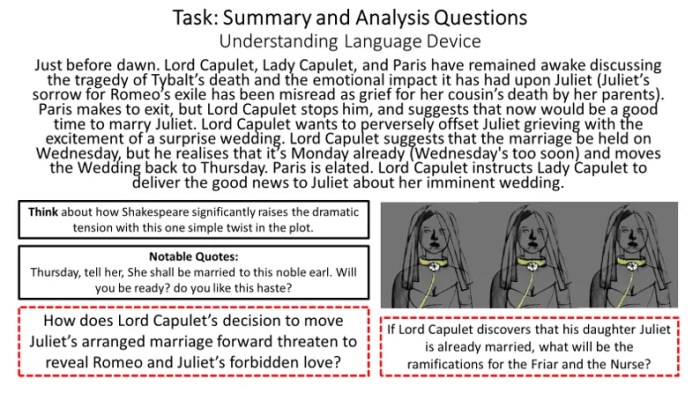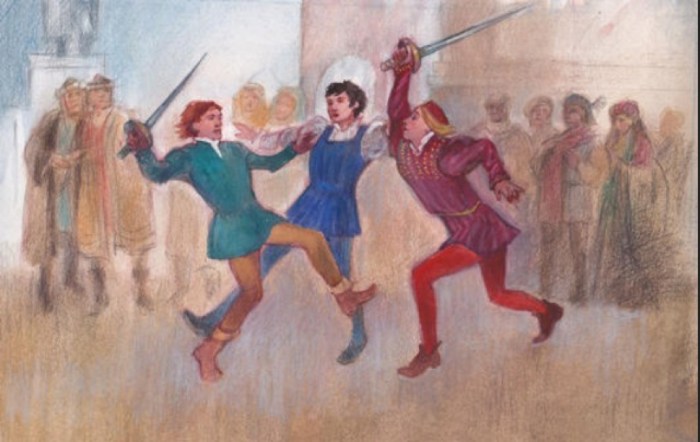Embark on an in-depth literary journey with our comprehensive Romeo and Juliet Act 3 Reading Guide. This guide unveils the intricacies of this pivotal act, delving into character development, conflicts, symbolism, and literary devices.
Act 3 marks a turning point in the tragic tale of Romeo and Juliet, intensifying conflicts and revealing the characters’ true natures. Our guide provides an insightful analysis, guiding you through the complexities of this captivating act.
Character Development

Act 3 of Romeo and Juliet witnesses significant character transformations, particularly in the relationship between Romeo and Juliet and the actions of Friar Laurence and the Nurse.
The evolution of Romeo and Juliet’s relationship is evident in their heightened emotional intensity and willingness to sacrifice for each other. Romeo’s rashness and impulsivity, exemplified by his duel with Tybalt, give way to a profound understanding of the consequences of his actions.
Juliet, once a demure maiden, emerges as a resolute and determined woman, willing to defy her family and even risk death to be with Romeo.
Friar Laurence and the Nurse
Friar Laurence’s role becomes more complex in Act 3. Initially portrayed as a wise and compassionate figure, his decision to marry Romeo and Juliet in secret becomes increasingly questionable as the consequences of his actions unfold. The Nurse, who initially acts as a confidante to Juliet, becomes more complicit in the lovers’ plot, but her loyalty is tested when she learns of Romeo’s banishment.
Conflict and Resolution
Act 3 of Romeo and Juliet witnesses an intensification of the conflicts introduced in earlier acts, propelling the plot towards its tragic climax.
Fate and external forces play a significant role in shaping the events of this act. The feud between the Montagues and Capulets escalates, leading to the deaths of Mercutio and Tybalt, two prominent characters. These events set in motion a chain reaction that ultimately culminates in the downfall of both Romeo and Juliet.
The Impact of Mercutio’s Death
Mercutio’s death is a pivotal moment in the play. His witty and Mercurial nature provides comic relief and a sense of balance to the otherwise somber tone of the play. His death at the hands of Tybalt not only removes a beloved character but also deepens the rift between the two families.
Romeo’s impulsive reaction to Mercutio’s death, where he kills Tybalt in a fit of rage, has far-reaching consequences. The Prince banishes Romeo from Verona, setting the stage for the tragic events that follow.
Symbolism and Imagery
In Act 3 of Romeo and Juliet, Shakespeare employs symbolism and imagery to enhance the play’s themes and provide deeper insights into the characters and their experiences.
The Moon
The moon serves as a symbol of romance, mystery, and change throughout the play. Its presence often accompanies significant moments, such as Romeo and Juliet’s first encounter at the Capulet ball. The moon’s ethereal glow illuminates the lovers’ secret rendezvous and highlights their passion and desire for each other.
The Nightingale
The nightingale, a bird associated with love and music, symbolizes the beauty and fragility of Romeo and Juliet’s love. Its song represents the lovers’ sweet and harmonious relationship. However, the nightingale’s song also foreshadows tragedy, as it is often interrupted by the harsh cries of the lark.
The Lark
The lark, a bird that sings at dawn, symbolizes the arrival of morning and the end of darkness. Its cheerful song contrasts with the nightingale’s mournful tune and marks the impending separation of Romeo and Juliet. The lark’s presence signals the arrival of Friar Laurence’s plan to reunite the lovers, but also foreshadows the tragedy that awaits them.
These symbols and images contribute to the play’s overall themes of love, fate, and tragedy. They enhance the emotional depth of the story and provide a deeper understanding of the characters and their struggles.
Language and Style

Act 3 of Romeo and Juliet showcases a heightened use of language and style, intensifying the play’s dramatic tension and emotional impact. Shakespeare employs various literary devices to create a vivid and immersive experience for the audience.
The characters’ speech is marked by heightened emotionality and passion. They express their love, despair, and anger through eloquent and poetic language, creating a sense of urgency and immediacy. The use of metaphors, similes, and hyperbole further amplifies the characters’ emotions, making them relatable and sympathetic to the audience.
Dramatic Irony, Romeo and juliet act 3 reading guide
One of the most striking features of Act 3 is the use of dramatic irony. The audience is privy to information that the characters do not know, creating a sense of suspense and anticipation. This technique is particularly effective in scenes involving Romeo and Juliet, as the audience is aware of their impending doom while the characters remain oblivious.
Foreshadowing and Dramatic Tension
Shakespeare also uses foreshadowing and dramatic tension to build suspense and create a sense of inevitability. The Nurse’s account of Tybalt’s death foreshadows Romeo’s banishment, while Friar Laurence’s warning to Romeo about the consequences of his actions creates a sense of impending doom.
These devices keep the audience on the edge of their seats, eager to see how the events will unfold.
FAQ Guide: Romeo And Juliet Act 3 Reading Guide
What is the significance of the moon in Act 3?
The moon serves as a symbol of romance, passion, and secrecy, illuminating the lovers’ nocturnal encounters.
How does Mercutio’s death impact the plot?
Mercutio’s untimely demise fuels Romeo’s rage and sets him on a path of revenge, leading to the tragic deaths of Tybalt and himself.
What is the role of Friar Laurence in Act 3?
Friar Laurence’s well-intentioned but ultimately misguided plan to unite Romeo and Juliet through a secret marriage sets in motion a chain of events that leads to their downfall.